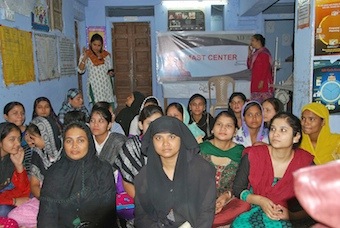
An Ancient Scene
By Betsy Dunklin
On Nov. 9, after our visit to the Taj Mahal and on our way to the Agra Fort, we rode through an agricultural area with miles of recently harvested flat land, providing a respite from clamorous and congested Delhi. We saw no villages or houses, just the highway and farm land. In the middle of nowhere, a restaurant appeared, where we had a buffet lunch.
In the restaurant, I was mesmerized by the scene outside the large arched windows. All was sepia-toned, with soft yellows and browns of the stubble remaining from the harvest, muted sage green of the occasional shade tree, and the perpetually murky sky caused by the inversion that arrives this time of year. These shades were punctuated by women farm laborers in brilliantly colored saffron, azure, crimson and fuchsia saris (calling them yellow, blue, red or pink just doesn’t do justice to the richness of the colors). Several of the women were using five foot long sticks to strike bundles of branches to knock out the dried lentils. Our guide, Sujata, explained that later they will strip the branches and weave them into rope. One of the women, who was tending a couple of large black cows, was knitting while standing. If I blocked out the busy highway bordering the fields and our restaurant, I could be looking at a scene from a thousand or more years ago.
This is emblematic of much that I have seen in India, the modern crashing into the ancient. For example, it is not unusual to see a man riding an elephant or camel-drawn carts on a major highway crammed with trucks, auto-rickshaws, motorcycles and bicycles. Goats, donkeys, and, of course, the sacred cows roam everywhere. I have seen them grazing in two-foot median strips of a very busy eight-lane highway (with 10-lanes of traffic and motorcycles squeezed between) as though they were on Ol’ McDonald’s back forty. In the midst of the warren of stores and light manufacturing side by side in the ubiquitous crumbling cement buildings will appear a several-hundred-year-old ornate palace, temple or mosque.
I wondered what it must be like for the women served by the projects we are visiting. They and their communities are coping with meshing an ancient way of life that changes only very slowly with the values and fast pace of modern life. Much of their dress and customs are the same as those of the medieval period, but they have cell phones and live amidst shops full of cheap modern manufactured goods in packaging that is strewn everywhere.
Yesterday afternoon, we had the privilege to talk to some of those women who are enrolled in Vatsalya’s project teaching them to sew discarded saris into quilt-like fabric used by Anchal to fabricate fashion for the U.S. market. (Urban Outfitters currently is selling fashions online that incorporate the fabric.)
To visit the site where the women are taught, we drove as far as we could into a Muslim neighborhood in Jaipur, our van just inches from the open fronts of houses, stores and work sites, with motorcycles, pedestrians, children, dogs, cows and goats squeezing between, unfazed. Finally, the van could go no further so we walked past the crumbling attached cement rooms, one with a man at a sewing machine, another with a man on a rug with his wares hanging from the wall, next men using their hands to put dirt through a sifter (for making more cement, perhaps?), then a closed door of carved wood, presumably to living quarters.
We arrived, took off our shoes before climbing down a few steps (steps are everywhere, uneven, and in unexpected places; we middle-aged-women with bad knees are doing our own sort of coping) and entered a dark room filled cheek-to-jowl with local women enrolled in the project. Chairs were passed around and squeezed in for us to sit on.
Most of the young women had colorful scarves loosely draped over their heads; a few who came in late were completely covered in black robes with only their eyes showing. Jaimala, who founded and directs this program as well as the orphanage we visited that morning, said that during their sewing lessons, they learn about women’s rights and self esteem. When they began the program three years ago, she said they all wore face veils, but they now feel free to show their faces. And what sweet faces! They were shy with us at first but quickly warmed to us.
We asked them how the project had changed their lives. One said she has more respect in her home because she is earning money. Several said they could send their children to private school. Jaimala explained that the public schools are so bad they are useless and the only way children can get ahead is by attending the private schools. (In Katherine Boo’s “Beyond the Beautiful Forevers” about a Mumbai slum, she wrote that teachers, who are poorly trained to begin with, rarely show up and often pay a fee to an untrained person to fill in for the day.) We left the meeting with smiles in our hearts and tears in our eyes.
